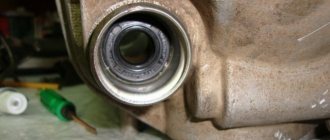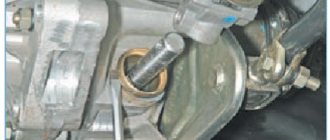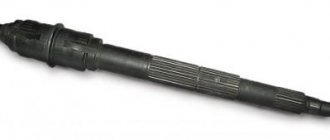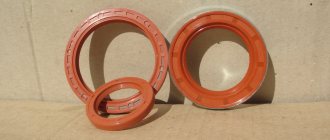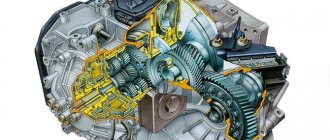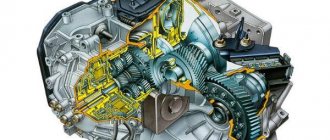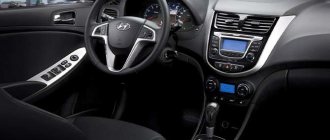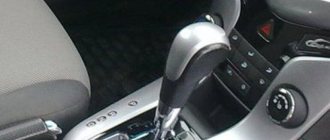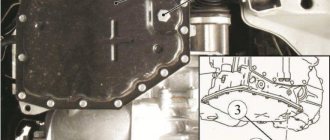Author: Evgeny Zhivoglyadov. Date of publication: August 01, 2022. Category: Automotive equipment.
To tightly connect rotating (or reciprocating) parts of a car with stationary parts of the structure, special sealing products are used - oil seals. Despite their apparent simplicity, it is difficult to overestimate their importance for the normal operation of a vehicle. These products, originally installed in the engine, steering, transmission parts, gearbox, cooling system and so on, naturally require periodic replacement. The length of their uninterrupted operation largely depends on how seriously you take the choice of oil seals.
Purpose
Reinforced rubber cuffs (oil seals) are designed to seal joints and also serve as protection against the penetration of dust and dirt into the assembly.
In most cases, they operate in air and come into contact with various process fluids: lubricant, fuel, emulsions or water. Oil seals are capable of operating in a wide temperature range from -60℃ to +170℃ depending on the technical characteristics of the material. The working pressure of the rubber cuffs is 0.05 MPa.
Replacement features
There is one important feature in replacing this spare part: on the motor shaft where the new oil seal will be installed, there may be considerable wear from the edge of the old one. In such a case, the part should be selected so that its edge is slightly offset relative to the original. You can also install a new part with a spacer ring, which will ensure that the edge shifts relative to the previous position.
When there is severe wear on the bearings in the motor shaft, it is advisable to choose oil seals with oil marks when replacing them. In this case, the part will last much longer than when choosing a spare part without such a device.
Before starting to replace the oil seal, it is necessary to determine exactly why the old part became unusable. In addition, it is important to understand exactly which problems can be successfully solved by replacing the old oil seal with a new one, and which such replacement will simply hide. An example of such a case could be damage to the surface of the shaft or its free movement, which is strictly unacceptable. Replacing the oil seal in this case may mask the problem for a while, but in the future this may lead to more serious damage.
Thus, the oil seal is an important part that is used in many moving and fixed joints. Its important feature is the replacement process, for the quality of which it is important to have special skills and knowledge.
This is such a small but still important detail. Now a short video.
That's all, read our AUTOBLOG.
Classification of oil seals depending on material
Oil seals are made from the following main types of rubber:
- Nitrile butadiene rubber.
An affordable material that can operate at temperatures from -45℃ to +100℃ depending on the working environment. Resistant to most fuels and lubricants.
- Fluorine rubber.
It is highly resistant to oils and chemical compounds. Can be used in highly loaded power units. The operating temperature ranges from -45℃ to +170℃.
- Silicone rubber.
For production, only rubber belonging to group 1 is used. Application is limited due to low resistance to certain types of oils. Operating temperature range – -55℃ to +150℃.
Operating principle and device
The essence of such a sealing device is as follows: inside its body, where the spindle axis passes through it, there is a “box”, inside it there is a special packing - sealing material. It is pressed tightly against the spindle axis.
In this case, compression of the sealant material occurs, as a result of which it fits tightly on one side to the surface of the spindle and to the walls of its chamber on the other.
As a result, complete tightness is created, which does not allow the working environment to escape beyond its housing.
In mechanisms with a small diameter, the sealing material is pressed using a union nut, with a large diameter - using anchor bolts.
Seal options
Reinforced rubber cuffs are produced in various designs, which differ in the type of outer surface. Some models do not have a boot, others provide additional protection from dust and dirt.
Seals with grooves
Oil seals with a continuous smooth outer surface at the landing site have not shown their best performance in practice, as they are prone to leakage. This negative phenomenon is a consequence of the formation of microfolds due to the lack of compression when pressing the seal. In addition, microscopic folds create conditions for dirt and dust to penetrate into the unit.
A more advanced technical solution was proposed - oil seals whose outer surface is corrugated. This improved the efficiency and reliability of the seal and eliminated leakage.
Knurled seals
The degree of pressing of the “lips” of the oil seal depends on the angular and linear speeds of rotation of the shaft. Until the moment when these parameters are in a certain range of values, designers do not have questions related to the tightness of the assembly. However, when the shaft operates at high speeds, eccentricity leads to displacement of the working surface of the edge and leakage of technical fluid.
To solve this problem, engineers used the hydrodynamic effect. The technical solution is to roll a “lip”, which in this case works like a pump impeller, that is, it directs the liquid tending to flow back. Knurling is performed in various ways at a certain angle depending on the direction of rotation.
Oil seals with reversible knurling
A reverse notch is applied to oil seals that are not intended for forced use. The use of such seals is more economical than left or right knurling during reverse rotation of the shaft.
Oil seals with bare frame
A “bare” oil seal does not provide a rubber layer, but is sealed by tightly fitting metal to metal using a special sealant. An additional technological operation increases the cost of serial production of reinforced rubber seals. However, this disadvantage is compensated by the reliable fixation of the part in the assembly compared to rubberized modifications.
“Half-naked” seals
This design of the seal includes a rubber component that provides high tightness, and a reliable fit is achieved due to interference when contacting metal to metal. “Half-naked” oil seals are more economical to produce compared to rubber-coated models, but more complex technologies and high-quality polymers are used for production. They find application in critical areas.
Oil seals with anthers
Some models of reinforced cuffs include anthers - an element that protects the unit from the penetration of dirt and dust. The boot serves as a barrier to relatively large particles that could damage the seal area.
Constructions
The frictional force that arises between the stuffing box and the rod prevents the latter from making the necessary movements, and if the stuffing box is tightened with excessive force, it makes them impossible, therefore, design and technological solutions are of great importance for the stuffing boxes to ensure their normal operation, among them:
- padding material;
- dimensions of the stuffing box;
- design of stuffing box parts;
- rod (spindle) material, surface finish and others.
In some cases (among fittings, usually in control valves), to reduce friction, oil seals with lubricant are used, which is supplied externally through a special grease nipple; in heavily loaded mechanisms, the rod is sprayed with water, for example, in drilling pumps.
Where are they used?
Oil seals in a car are mainly used in its power unit. So, in each engine there are two such parts in the crankshaft, and in those models that use a toothed rubber belt, also in the shafts that come out of the engine.
Thus, a car engine has the following types of similar devices:
- Front for crankshaft;
- Rear for crankshaft;
- For balancer;
- For oil pump.
All of them must be made from heat-resistant material, since the rapid rotation of the parts causes the seals to heat up. If they are made from an ordinary non-heat-resistant substance, they will burn and be completely destroyed.
Replacing the front-wheel drive oil seal on VAZ-2108, VAZ-2109, VAZ-2110, VAZ-2115 cars
Is the front wheel drive seal leaking ? Thoughts like: How expensive is it to replace an oil seal? Is it possible to replace the oil seal with your own hands? And how difficult is it to replace it? Yes!? Then you have come to the right place... I can say for sure that it is not difficult, and you can easily carry out the work yourself. Of course, only if you have the desire, the necessary tools and precise instructions for correctly replacing the front wheel drive oil seal on VAZ-2108, VAZ-2109, VAZ-2110, VAZ-2115 from the Auto Repair School website! ))) Well, as they say, from words to deeds! Let's move on to the description of the main thing - a list of tools, purchasing spare parts and the process of replacing the drive seal with photographs
Tools: 17mm wrench, 30mm socket wrench with long knob, pry bar, screwdriver, container for draining oil, hammer and mandrel for neatly pressing the oil seal. You can also use an old oil seal to mount the drive seal. But this is not very convenient. It’s easier, after all, to buy an oil seal and select a piece of pipe of a suitable diameter for it.
Spare parts: when purchasing a drive oil seal, you must know exactly which side you need it for. Since the oil seals of the left and right drives differ in the direction of the oil drainage notches. There are three main differences from each other. First, the direction of the arrows on the inside of the seals. On the right oil seal, the arrow indicates movement to the left, and on the left, to the right. The second difference is the numbers at the end of the catalog number. The number on the right oil seal ends in an even number (4), on the left oil seal – in an odd number (5). And the third, exactly applies to Balakovo-made oil seals, is the color of the oil seal itself. Right black, left brown (photos 1 and 2).
Let's move on to the description of the process of replacing the front wheel drive oil seal on VAZ-2108, VAZ-2109, VAZ-2110, VAZ-2115 :
We drive the car into a pit or overpass and drain the oil from the gearbox. You don't have to drain everything. It will be enough to drain about one liter. Loosen the wheel bolts and unscrew the front hub bearing nut (photo 3).
We jack up the car and unscrew the two bolts securing the lower ball joint to the steering knuckle (photo 4). Having installed the pry bar between the body and the anti-roll bar, push the lower arm down. And pull out the end of the drive from the hub.
After that, we climb under the car and, using a pry bar or mounting blade, leaning on the boss on the gearbox housing, push the drive out of the gearbox (photo 5). At this moment, if you forgot to drain the oil from the box, the fun will begin))).
Using the same pry bar or screwdriver, we pull out the oil seal from the gearbox (photo 6).
AND …. We can press in a new oil seal (photo 7). We do not press the oil seal all the way, namely as shown in photo 8.
We carry out assembly in reverse order. Don't forget to fill the gearbox with oil!
When using an article or photographs, an active direct hyperlink to the website www.avtorem.info is required!
Did you like the article? Share it on your page!
Selection rules
When choosing a seal yourself, it is recommended to give preference to the original or a high-quality analogue. Particular attention is paid to labeling, which every manufacturer necessarily supplies its products with:
- “VA” – for camshafts;
- “BASL” – for improved protection against dirt;
- “B1” – for uneven and worn surfaces;
- “B2” – with an additional metal ring for large diameters;
- “BA0F”, “B10F” – without a spring element;
- “DRL (RS)” – with a left notch on the inner surface;
- “DRW (RD)” – with a right notch on the inner surface;
- “D” – for limited pressure indicators (no more than 2 bar);
- “B” – for limited pressure indicators (no more than 10 bar);
- HD – for limited pressure indicators (no more than 100 bar);
- “RT” – with Teflon surface (PTFE);
- “UD” – with a universal profile;
- “U” – with the presence of the old profile.
Signs of a torque converter malfunction
I consider the first sign of a torque converter malfunction to be a leaking oil seal. If you notice that the car leaves oil traces, then the automatic transmission is clearly overheating. And when we completely disassemble the box at a service station, we will also find burnt clutches.
Read
Do-it-yourself repair and replacement of automatic transmission valve body
If you do not notice an oil leak, then after driving 1,000 kilometers, you will hear extraneous sounds and vibration from the machine. The car will jerk when shifting from second to third gear at a speed of 60 kilometers per hour.
Each automatic transmission is given time that it can run without major repairs. But even for unkillable machine guns, the oil seal failure period is equal to 150,000 kilometers.
No matter how you take care of the automatic transmission, change the oil at the required interval, or monitor the general condition, the automatic transmission will still come to our service station. True, the torque converter oil seal can be replaced during scheduled maintenance, since we check all automatic transmission components when we carry out preventive maintenance on the car.
This is why it is so important to attend scheduled maintenance on time.
How often do you visit service centers and do you perform preventative automatic transmission procedures? Write in the comments.
TCM-Club
Official forum TCM-Club (Toyota Ceres Marino Club)
- Entrance
- Registration
- Links
Current time: Thu Aug 26, 2022 5:24 pm
Drive oil seal and its replacement
- Author
- Message
Drive oil seal and its replacement
Post by E.dubinin » Wed Sep 23, 2009 4:08 pm
Please tell me how to replace the drive seal on the automatic transmission. Does anyone have a diagram?
TOPIC MOVE! Author, write in the section intended for this. Postal
Re: Drive oil seal and its replacement
Post by DJ » Wed Sep 23, 2009 6:49 pm
Re: Drive oil seal and its replacement
Post by Volodya » Wed Sep 23, 2009 6:58 pm
_________________
ICQ:367146577 [email protected] » target=»_blank» target=»_blank Toyota Chaser -105 body, V2500-200 ponies, 4WD
Re: Drive oil seal and its replacement
Post by Gosha779 » Wed Sep 23, 2009 7:23 pm
Re: Drive oil seal and its replacement
Post by E.dubinin » Thu Sep 24, 2009 8:32 am
Re: Drive oil seal and its replacement
Post by oXi » Mon Sep 28, 2009 11:16 pm
When I pulled the drive out of the automatic transmission, the dextron leaked. (oil does not flow on the bellows).
In general, this is what I did as a replacement:
- drained the fluid from the AT - took off the wheel - turned the steering wheel max to the right (if we remove the right drive) or to the left (if we remove the left one) - unscrewed the ball from the lower arm (2 nuts + 1 bolt) - pulled the drive out of the gearbox (there are splines at the end of the drive and a retaining ring, so in order to pull it out of the gearbox you need to apply a lot of force), but it will not completely come out of the AT. Therefore, we move the unscrewed hub away from the car and finally remove the drive from the box. — next, remove the old oil seal (it’s simply pressed in there) and press in a new one. - assemble in reverse order.
AutoXS.ru - Auto Encyclopedia
Today I want to talk about the sealing elements of almost any internal combustion engine - in simple words, oil seals.
Many of you have heard about them, but not many have any idea what they are and where they are installed. However, despite the entire prostate structure, they perform important tasks, such as retaining lubricating fluid in the units. Today I will try to talk about these elements in simple and understandable language. Stuffing box
- a device that is used in a car to seal the joints of various parts and rotating shafts that operate on the principle of reciprocating movements.
The main function they perform is complete sealing of the joints of fixed or moving surfaces.
In simple words, they seal the shafts and the “walls” of their housings, preventing lubricating fluid from leaking out.
